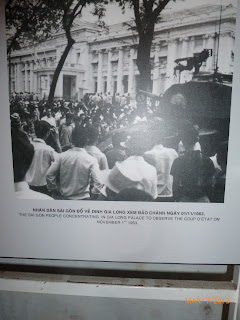We see some high rise buildings in the area, and figure one
of those will get us a view over the wall.
We go up the elevator to the highest floor in one of the buildings. There is no good vantage point from this
building, so we find another one.
When we get to the top floor of this second building, we do
get a view, although there really isn’t anything to see. We take pictures anyway.
 |
| American Consulate grounds |
View of the city
Another view of the city
Back on the ground, Ken is determined to get a picture of
the front of the consulate. Again, the
only reason he wants it is because he was told not to take pictures. He can be stubborn.
We approach the consulate from a side street with lots of
cars parked. Ken figures this will provide
cover, and he gets a picture of the Great Seal above the gate. He is pleased with himself.
The forbidden picture
After this escapade, we go back to the downtown area and find a restaurant for our last day’s lunch. We make our way back to the hotel, where we arranged for a late checkout. We shower and get cleaned up for our long journey home.
Our guide and driver are to pick us up at 5:30. This concerns me a little as the airline
recommends arriving at the airport three hours before the flight.
We do get picked up on time, but are at the height of rush
hour traffic. Evening rush hour in
Saigon is something to behold. Every
square inch of road space and sidewalks is taken up by traffic. Scooters and motorbikes will swoop in and
take any available opening between cars.
What this means is only one car (but a thousand other vehicles) can get
through each green light.
To get an idea of rush hour traffic, clik the link below or copy and paste. This is Youtube video shot by someone about a month before we were there.
To get an idea of rush hour traffic, clik the link below or copy and paste. This is Youtube video shot by someone about a month before we were there.
http://www.youtube.com/watch?v=MGAkESdKomo&noredirect=1
I express concern about getting to the airport on time. The only effect this has is to make the
driver nervous. He is an excellent
driver, and has the skills and nerves to navigate the traffic. He does find some alternate routes that are
marginally better.
We get to the airport two hours before the flight, and this
turns out to be plenty of time. We get
checked in, and then head for the security lines.
Ken sets off the security check alarm because of his
titanium hip. He gets patted down. I get stopped by the security agent who tells
me I have a pair of scissors in my carry-on luggage. I tell her I don’t have scissors. She says she saw them on the image as the bag
went through the scanner.
She instructs me to open the bag. As I’m doing so, it occurs to me the first
aid kit my wife Kathie gave me for Christmas might be the culprit. Sure enough, I pull out the first aid kit,
open it, and retrieve a pair of blunt-nosed bandage scissors.
I explain to the agent they have a blunt-nose and are not
dangerous. Smiling, she says, 'But the
blade is sharp.' She then takes her
finger and makes a slashing motion on her throat. Not knowing if she is just illustrating how
the scissors could be used as a lethal weapon, or if she is threatening me, I
hand over the scissors.
Having made the world safe again, I am allowed to
proceed. This was the 8th
airport screening we had gone through on this trip. And finally, I was caught. I almost made it.
Our flight is delayed and is completely full. This causes us to have to do a repeat
marathon through the Dubai airport to make our connection back to Dulles.
We do make the flight.
Ken is in the window seat and I am in the middle one, with a Nepalese man in the
aisle seat. Ken notices a couple of
empty aisle seats ahead of us. He tells
me we can grab them after the plane doors are shut. Unfortunately, someone else grabs one before
the doors are shut.
As soon as the doors are shut, I grab the other empty aisle
seat. What’s nice is the middle seat in
this row is empty. After I leave the
middle seat, the Nepalese man moves one of his children from the adjoining set
of seats to the one I vacated. The
child apparently had a dirty diaper. Ken
suffers for the entire fourteen and a half hour flight.
We land at Dulles at 8:00 Saturday morning. Our bags are the first ones off the plane,
and we are the first ones through Customs.
We are waved through, and Ken’s friend Nancy picks us up and takes us to
Ken’s house. Thus completes our almost
three week journey back to Southeast Asia. It has been an incredibly fine trip.



























































